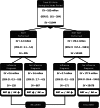A National Study of the Impact of Rapid Influenza Testing on Clinical Care in the Emergency Department
- PMID: 24872879
- PMCID: PMC4036423
- DOI: 10.1093/jpids/pit071
A National Study of the Impact of Rapid Influenza Testing on Clinical Care in the Emergency Department
Abstract
Background: Rapid influenza diagnostic tests (RIDT) may influence physician decision-making. Single-center studies suggest that influenza diagnosed in association with RIDT reduces ancillary testing and antibiotic prescribing. The extent of RIDT use in US emergency departments (EDs) and their impact on patient management are unknown. We examined the use of RIDT and its effect on influenza management, using a national sample of ED visits.
Methods: We performed a retrospective study using data from the National Hospital Ambulatory Medical Care Survey, an annually administered survey capturing a nationally representative sample of visits to US EDs. We identified patient visits in which RIDT was performed and/or influenza was diagnosed across 3 influenza seasons (2007-2009). Ancillary testing and antibiotic and antiviral prescribing were evaluated for 2 groups of patients in whom RIDT was performed (those given or not given a diagnosis of influenza) and a third group in whom influenza was diagnosed but RIDT was not performed.
Results: Rapid influenza diagnostic tests were performed during 4.2 million visits. Forty-two percent of influenza diagnoses were made in association with RIDT. For patients diagnosed with influenza, ancillary test ordering was lower (45% vs 53% of visits) and there were fewer antibiotic prescriptions (11% vs 23%), and antiviral use was higher (56% vs 19%) when the diagnosis was made in association with RIDT.
Conclusions: Influenza diagnoses made in association with RIDT resulted in fewer tests and antibiotic prescriptions and more frequent use of antivirals. This finding suggests that test results influence physician behavior.
Keywords: emergency department; influenza; influenza testing; rapid diagnostics; rapid influenza testing.
© The Author 2013. Published by Oxford University Press on behalf of the Pediatric Infectious Diseases Society. All rights reserved. For Permissions, please e-mail: journals.permissions@oup.com.
Figures


References
-
- Arnold SR, To T, McIsaac WJ, Wang EE. Antibiotic prescribing for upper respiratory tract infection: the importance of diagnostic uncertainty. J Pediatr. 2005;146:222–6. - PubMed
-
- Poehling KA, Zhu Y, Tang YW, Edwards K. Accuracy and impact of a point-of-care rapid influenza test in young children with respiratory illnesses. Arch Pediatr Adolesc Med. 2006;160:713–8. - PubMed
-
- Uyeki TM, Prasad R, Vukotich C, et al. Low sensitivity of rapid diagnostic test for influenza. Clin Infect Dis. 2009;48:e89–92 - PubMed
-
- Bonner AB, Monroe KW, Talley LI, et al. Impact of the rapid diagnosis of influenza on physician decision-making and patient management in the pediatric emergency department: results of a randomized, prospective, controlled trial. Pediatrics. 2003;112:363–367. - PubMed
-
- Falsey AR, Murata Y, Walsh EE. Impact of rapid diagnosis on management of adults hospitalized with influenza. Arch Intern Med. 2007;167:354–60. - PubMed
Grants and funding
LinkOut - more resources
Full Text Sources
Other Literature Sources

